Secular Lyric
The Modernization of the Poem in Poe, Whitman, and Dickinson

This book can be opened with

In this thoughtful and original study John Michael explores the ways in which Poe, Whitman, and Dickinson adapted and re-shaped the lyric in response to the challenges of secular modernity. His book will be of interest not only to those wishing to learn more about these three poets but to those curious about the fate of the lyric in a world increasingly defined by secularism and by all the paradoxes such a development can bring.—Kerry Larson, University of Michigan
This book offers a fresh look at the three most significant American poets of the 19th century: Edgar Allan Poe,
Walt Whitman, and Emily Dickinson... All readers will find much to consider in this concise and thoughtful book... Highly recommended.
Secular Lyric will not only be useful for its provocative arguments about the lyric, and for its investigations of posthumanist materialism in nineteenth-century poetry, but also, one hopes, as a provocation to consider anew two ideas of a secular world. In one, the secular world is a place in which, without an unquestioned, transcendent ground on which to place our views, we are thrown into discussion about goals, effects, benefits, and motives for beliefs and actions. In the other, the secular world is a place of shifting sensations and abutting objects, in which material anonymity is the one absolute truth that can be relied on.
Introduction. The Secularization of the Lyric: The End of Art, a Revolution in Poetic Language, and the Meaning of the Modern Crowd
Part I: Edgar Allan Poe
1. Poe’s Post-Humanism
2. Poe and the Origins of Modern Poetry: Tropes of Comparison and the Knowledge of Loss
Part II: Walt Whitman
3. Whitman’s Poetics: Metonymy and the Crowd
4. Whitman and Democracy: The “Withness of the World,” the Reader, and the Fakes of Death
Part III: Emily Dickinson
5. Emily Dickinson: The Poet as Lyric Reader
6. Dickinson’s Dog and the Conclusion
Acknowledgments
Notes
Index

